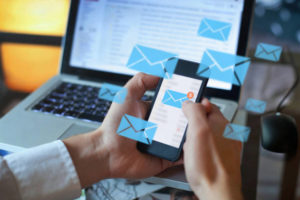Email marketing with Mailchimp is so flexible and it’s easy to send emails that really click.
How does email marketing start?
The first email, sent by Ray Tomlinson in 1971 or 1978 depending on the source, marked the beginning of the modern communication era. The message was nothing special, a series of numbers and letters that looked more like a password than a message, but its meaning was profound.
The email was sent from one computer to another, traversing a network of computers not unlike today’s Internet. Tomlinson also introduced the “@” symbol to email addresses around the world.
Gary Thuerk, a marketing manager at Digital Equipment Corp, sent the first commercial email reaching a list of email addresses years later. And voilà, email marketing was born. The list only included a few hundred people, but that was enough for Thuerk to earn the title “father of spam”
Today, we’re inundated with email marketing campaigns, and yes, some of them still feel spammy, but there’s no denying the impact a well-crafted message can have on your customers — not to mention CRM and lead nurturing. According to research, there will be 4.6 billion email users worldwide by 2025.
Email marketing, does it really work?
If you want to communicate something about your brand or sell your products, email marketing is one of the most cost-effective ways to do this.
A 2015 study by the DMA found that email has an average return on investment (ROI) of $38 for every dollar spent. When customers are ready to make a purchase, they often look for emails from their favorite stores.
Yet people are receiving more and more emails, and it can be difficult to stand out in the crowded inboxes. That’s why Mailchimp gives you the tools you need to shine (plus we have lots of proven tips for sending great emails) and develop effective email marketing campaigns. Read our email marketing statistics by industry to learn more about why email marketing works.
How do I get an email list?
You’ll realize the highest ROI if you build and maintain an engaged subscriber list made up of people who want to receive your messages (and who have intentionally signed up). Although building a clean list requires more work at the beginning of your email marketing strategy, Mailchimp lists have built-in tools to help you do this.
There are many ways to find people who look forward to receiving your emails, but we’ve put together a few that work best.
How do I build an Email List?
- Create a registration form on your website. When people come to your website for the first time and like what they see, they will want to continue to be informed about your brand. Create a newsletter sign-up form and install a pop-up to collect customer data from your visitors.
- Use a good old-fashioned sign-up sheet. Whether it’s in your retail store or at an event you’re hosting or attending, if you’re surrounded by people who are interested in your products, give them a way to sign up and learn more.
- Encourage sign-ups via social media. If you don’t have an extensive email list (or just want it to grow), but have an engaged following on social media, tap into that resource. Share your sign-up form on your social channels.
Can I buy an email list?
No. You should not buy an email list (and if you use Mailchimp, you cannot use a purchased email list).
Purchased lists are ineffective and will also affect all other Mailchimp users. If you send emails to a list of people whose contact information you have purchased, many of the emails will be identified as spam, and you will also get high unsubscribe rates. Some email spam filters will flag an email campaign if someone with the same IP address has sent spam in the past. If you use Mailchimp, your emails are delivered via our servers. So if one person sends spam, this can result in other users’ emails not reaching their inbox. By prohibiting Mailchimp users from using purchased lists, we increase deliverability for everyone.



